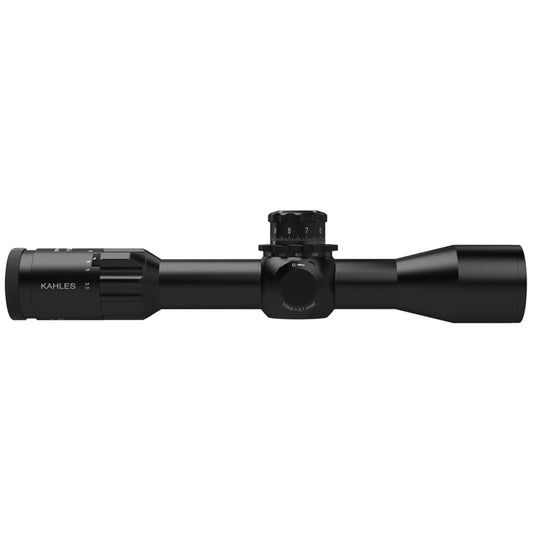

Kahles K328i 3.5-28x50mm DLR CCW SKMR4+ Riflescope delivers precision and reliability for shooters at any skill level. Its DLR elevation turret features 100 clicks of adjustment per revolution, allowing for rapid and accurate adjustments during dynamic shooting scenarios. With a Zero Stop function, quickly returning to your zero setting is straightforward, while the twist guard prevents accidental adjustments, ensuring your settings remain intact. The optical design provides a wider field of view, enhancing situational awareness in various shooting environments.
This first focal plane scope features an illuminated reticle that remains clear across the entire magnification range, making it ideal for low-light conditions. The comfortable eye box allows for extended use without strain, making it suitable for precision shooting or competition. With reliable repeat accuracy, the K328i DLR is built to meet the demands of serious shooters who prioritize performance and precision.
Features:
- WIDE FIELD OF VIEW for improved situational awareness while shooting.
- COMFORTABLE EYE BOX allows for prolonged use without discomfort.
- 100 CLICKS PER REVOLUTION ensures rapid adjustments for dynamic shooting.
- ZERO STOP FUNCTION provides quick returns to original zeroing for confidence.
- TWIST GUARD PROTECTION prevents unintentional adjustments during use.
- PRECISE ILLUMINATED RETICLE in first focal plane for enhanced visibility.
- RELIABLE REPEAT ACCURACY ensures every shot counts, shot after shot.
- PATENTED PARALLAX ADJUSTMENT integrated in the turret for versatile distance settings.
Technical Specifications Table
| Feature | Detail |
|---|---|
| Magnification Range | 3.5x - 28x |
| Objective Diameter | 50mm |
| Exit Pupil | 1.8mm - 7.4mm |
| Field of View | 42.9ft. - 5.4ft. @ 100yds. |
| Weight | 36.7 oz |
| Scope Length | 14.2 in. |
| Turret Adjustment (Click Value) | 0.1 MRAD |
| Windage Turret Rotation | Counter Clockwise (CCW) |
What’s in the Box?
- Lens covers
- Padded case
- Neck strap
Customer Reviews
"Absolutely love the clarity and precision of this scope. Perfect for my long-range shoots!"
"The DLR turret is a game-changer. Quick adjustments and reliable performance every time."
FAQ
What is the advantage of an FFP reticle?
With a first focal plane reticle like the SKMR4+, the reticle scales with magnification, ensuring your holdovers and windage adjustments remain accurate at any zoom level.
How durable is the K328i DLR?
This scope is designed to withstand harsh conditions, making it suitable for both field and competitive use. It's built to last with robust materials and construction.
Can I use this scope for hunting?
Absolutely! The K328i DLR is versatile enough for hunting, target shooting, and competition. Its wide field of view and precise adjustments make it ideal for various shooting environments.
Similar Models
Looking for more exceptional optics? Explore our extensive Kahles lineup, including models like the Kahles K624i for unmatched clarity and the Kahles K16i for a compact option that doesn't compromise on performance. Discover our full collection of precision shooting gear tailored to elevate your performance.
You May Also Like
Here’s some of our most similar products people are buying. Click to discover trending style.










